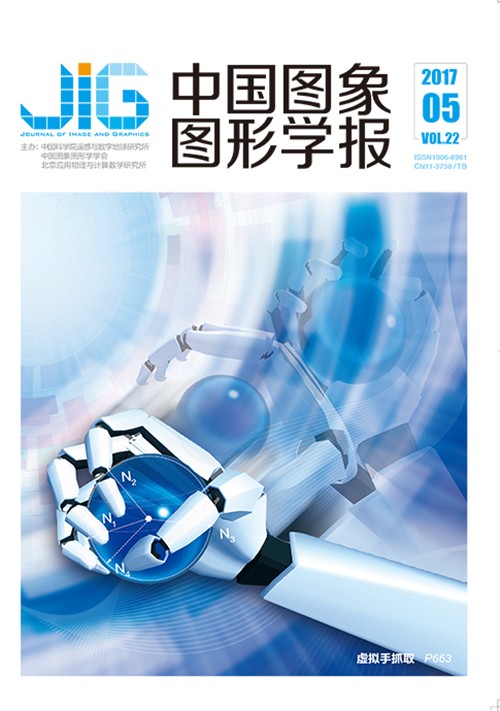
矢量道路拓扑追踪匹配算法
李翔1,2, 马爽3, 杨辉4, 张晓楠5(1.信息工程大学地理空间信息学院, 郑州 450001;2.地理信息工程国家重点实验室, 西安 710000;3.郑州铁路局郑州车站, 郑州 450052;4.69027部队, 乌鲁木齐 830002;5.空军航空大学, 长春 130022) 摘 要
目的 基于道路形状特征的匹配算法在匹配性能上比较稳定,但当遇到道路交叉口等复杂路况时容易出现误匹配,且实时性上有一定缺陷,而矢量道路良好的拓扑结构,为此提出一种利用矢量道路拓扑关系进行追踪匹配的算法。方法 算法利用结点、路段和路口这3种对象来对矢量道路进行表达,建立各个对象之间的拓扑关系,并将匹配过程划分为4个不同的状态,根据各个状态实施相应的匹配方法。首先,进行初始化、追踪、路口和搜索4个状态的定义和划分,确定各个状态之间的转换关系;进一步,设计道路中的结点、路段和路口3种对象的数据结构,建立点、线之间的空间拓扑关系;其次,根据4个状态的具体任务和实际特点,对进入该状态的行驶轨迹进行相应地分析处理和匹配计算;最后,根据追踪的结果进行匹配分析,完成对车辆行驶轨迹的误差修正。结果 采用GPS-RTK采集的北京市西五环及密云地区的矢量道路数据对实地跑车的惯性导航轨迹进行拓扑追踪匹配仿真实验,完成拓扑追踪匹配算法的路口距离阈值选取,并与传统基于道路形状特征的匹配算法在匹配效果和实时性进行性能对比测试,其性能指标为匹配准确率和匹配时间。当矢量道路拓扑追踪算法的路口距离阈值取20 m时,匹配准确率达到了最高值93.5%。在匹配性能对比上,拓扑追踪算法相较于其他两种算法也有一定优势,在相同道路段中匹配准确率达到了90.2%,匹配速度也提高了48倍。结论 采用矢量道路数据的拓扑信息对车辆轨迹进行追踪匹配的方法,能够用于卫星信号“盲区”或者信号干扰等特殊环境和场合的组合系统辅助导航,弥补传统基于卫星的组合导航在自主性、抗干扰性的不足。同时,算法针对复杂路况的匹配结果也较为理想,能够满足组合导航匹配工作的要求。
关键词
Vector road matching algorithm based on a topological path
Li Xiang1,2, Ma Shuang3, Yang Hui4, Zhang Xiaonan5(1.Institute of Survey and Mapping, Information Engineering University, Zhengzhou 450001, China;2.State Key Laboratory of Geo-information Engineering Xi'an 710000, China;3.Zhengzhou Railway Bureau, Zhengzhou Railway Station, Zhengzhou 450052, China;4.Troop 69027, Wulumuqi 830002, China;5.Air Force Aviation University, Changchun 130022, China) Abstract
Objective The aided navigation method based on track matching has evident advantages in both anti-external interference and independence. Its key concept is to compare high-precision road data in navigation electronic maps or network databases with vehicle trajectory data obtained from sensor measurement. The location of a vehicle can be determined based on road information; hence, the error of an integrated navigation system can be prevented and localization accuracy can be improved to a certain extent. In the case of special road conditions such as intersections, cross bridges, or ramps, several false road matches can occur, which directly affect the positioning of navigation results. A vector road, which is generally composed of discrete point sets, exhibits a high degree of accuracy in positioning coordinates and topological relations. Thus, the relationship between road topology and path can be fully utilized in a matching algorithm. A vector road matching algorithm based on road tracing is proposed to address the problem in matching algorithms based on road shape feature. Method A road is preprocessed into a ring topology, which includes nodes, roads, and intersections, in accordance with road requirements. The four states are divided as follows:initialization, tracing, intersection, and searching. The algorithm begins to process the road tracing based on actual state characteristics. During road tracing, different processing steps can be performed for the matching. The error correction of vehicle trajectory can be achieved by analyzing the road tracing results. Moreover, the algorithm also statistically analyzes the road tracing conditions for intersection tracking under different thresholds to ensure the accuracy of the matching results. The vector road matching algorithm based on topological path tracing can considerably improve the results of navigation error correction in real time and eliminate mismatches due to complex junctions and other sections. Repositioning can be rapidly performed via the search set from the state of positioning loss. The distance thresholds on the intersection are set for accurate intersection state matching, which can be selected according to the field condition of the corresponding distance value. Result The vector road data of Beijing city west 5th ring and the Miyun area were obtained via the Global Positioning System (GPS)-Real Time Kinematic, and the inertial navigation trajectory data of field cars were adopted in the simulation experiments. The selection of the intersection distance threshold and the comparison tests for the matching effect and real-time performance between the proposed algorithm and the traditional matching algorithm based on road shape feature are completed during the experiment. Matching accuracy and matching time are used as the standards for every test. The results show that when distance threshold is 20 m, the intersection matching exhibits the highest accuracy, which can achieve a maximum value of 93.5%. This study verifies the effect of the algorithm in a real road test. The experimental results show that the proposed road tracking algorithm demonstrates better matching accuracy for driving on intersections than the traditional algorithm based on shape. Its matching accuracy rate is 90.2%, and its matching speed increases by 4 to 8 times in the same road segment. The vector road matching algorithm based on path tracing has evident advantages in terms of real-time tracking and the matching effect. The algorithm is simple, feasible, and its matching accuracy is higher, thereby effectively fulfilling the requirements for integrated navigation matching. Conclusion The proposed algorithm has several advantages over the traditional matching algorithm, including higher accuracy rate, excellent stability, and faster match speed. It can be used to aid in integrated navigation under special conditions, such as a GPS signal blind zone and signal interference environment, to compensate for the lack of autonomy and anti-interference in traditional navigation based on satellites. The experiments also demonstrate the effectiveness and practicality of the proposed method.However, the algorithm still requires further optimization and analysis in terms of adjusting parameters as well as more matching methods. We aim to devise more effective aided information and matching methods for integrated navigation in the future.
Keywords
|



 中国图象图形学报 │ 京ICP备05080539号-4 │ 本系统由
中国图象图形学报 │ 京ICP备05080539号-4 │ 本系统由